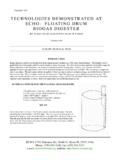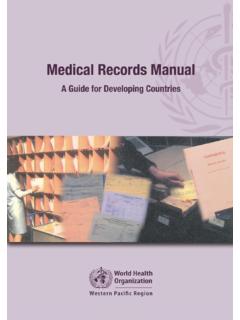Transcription of A Small- Scale Biodigester Designed and Built in the ...
1 A small - Scale Biodigester Designed and Built in the Philippines by Gerry Baron (Quoted with his kind permission). Introduction: (Click the pictures for a high resolution version). I am a semi-retired engineer in the poultry and piggery business. It's been many years since university chemistry and biology classes. The Philippines is a tropical country with just a dry and a rainy season. Ambient temperature is in the 30 C to 40 C range year-round -- ideal for biogas. The temperature under direct sun can be much higher. (I have to put shades on some of my digesters!). For waste management and pollution control, the Department of the Environment and Natural Resources (DENR) has been promoting biogas production in large pig farms specially those already equipped with waste lagoons.
2 Unlike India and their huge Gobar supply, cattle farms are few in the Philippines. We have many pig and poultry farms. We don't have a "Gobar Gas Research Station". We have very little information, promotion and programs for biogas specially for small - Scale systems. Compared to India's million family-type biogas digesters in 2000, there are probably less than 100. such units in the Philippines. ( ). My interest in biogas is motivated primarily by its ability to replace LPG as a cooking gas for most rural households. Its ecological benefit is an added bonus. With 4-200 liter test digesters working since June and a 2 cubic meter (m3) demo digester working for more than a month, I continue to be very interested with my experiments - "a very useful hobby".
3 My most efficient digesters use 5 % poultry-manure by volume charged once every 2. weeks. (My 2 m3 digester is fed 100 liters of pre-soaked and well-stirred manure every 2. weeks.) Biogas yield starts at 60 % and drops to 40 % before the next feeding. The biogas output of my old poultry-manure test digester has dropped sharply at the end of the 5th month. Could it be because of Nitrogen overdose? Except for a small amount of effluent displaced during charging (usually 50 % of charge volume), there appears to be no sediments in the digester. All manure seems to liquefy. I. understand excess nitrogen goes out with sludge and turns into a nitrogen-rich fertilizer. I am also concerned about anaerobic bacteria over- population and in-sufficient charging.
4 Grass or biomass is a good alternative but because it floats it will be difficult to load in my digesters. Besides it requires additional work. I chose to work with poultry- manure after getting lesser biogas yield from pig-manure. My 2 m3 digester produces 1. m3 of biogas daily for cooking. It uses 100 liters of poultry-manure once every 2. weeks. It is a very inexpensive and practical system. It's something that will appeal to many rural folk. Everyone is welcome to see my demo unit and copy it. I may even provide drawings for FREE. This is my primary objective. The Biodigester in action - The hard work pays off and produces a clean-burning flame from biogas. Without the piece of wood on top of the burner it would be completely invisible, except perhaps for a heat haze!
5 It can work, and the construction is not complicated. Fuel produced from manure is clean and cheap. It can be produced where it is needed from simple raw materials. From a business viewpoint, I plan to sell ready-to-install kits when my design has become problem-free. I also hope to provide design consultancy and building capability for larger applications. The general design can be found here: Biodigester design (My aplogies to all who tried to follow the broken link before). Design considerations I admit my design is very basic and simple. Valves 1 & 2 were not even in my test digesters and in the m3 tarpaulin digester shown in the pictures. To remove effluent and sediments, I had to siphon or pump.
6 I added these valves in the two m3 HDPE digesters we Built and started up a few days before Christmas. The digesters are partially below ground so removing sediments will not be as simple as opening valve 2. But, the sediments should flow out with increasing pressure in the digester and opening valve 2. My previous digesters have not produced appreciable quantities of sediments so my experience in this area is limited. With the 10 m3 HDPE digesters, I plan to install another digester or small ponds downstream to collect the sludge (fertilizer) and use the effluent for watering plants. Codigestion experiments: I expect the HDPE digesters to begin producing gas last week of January. I will also begin using fruit and vegetable wastes (biomass) in one of my 200 liter test digesters.
7 I might also use said wastes in my 2nd m3. HDPE digester. I have managed to test a few carbon based feedstocks as we last discussed. They are: 1. lawn-mower grass cuttings from the greens of a nearby golf course 2. shredded sweet potatoes (yams) - from waste bin in vegetable market 3. shredded potatoes - from waste bin in vegetable market 4. sliced tomatoes - from waste bin in vegetable market 5. pressed coconut meat - from a native cake bakeshop The sliced tomatoes and pressed coconut meat did not appear to produce biogas. (When fed to a working digester, biogas output continued to decline as if no feedstock was added.). Worse, the pressed coconut meat floats and may be floating inside the digester impeding digestion.
8 With the grass cuttings, gas production did not drop. In fact, there was a small noticeable increase for a few days. The yams and potatoes, however, gave a surge in biogas production for a few days. Yams and potatoes (apparently, vegetables that cause flatulence) are good for biogas production. In all instances, approximately 5 % feedstock by volume was added once and production was observed for two weeks. I plan to repeat the tests and validate the results. Returning from a vacation, we passed a little, remote community that had signs saying they were using biogas. We stopped, interviewed two users and examined their set-ups. Though they invested heavily when their digesters were Built in 2001, they are very happy to have them now that LPG prices have almost tripled.
9 I was able to track down one of the technicians who happily reported that he has Built 41. digesters ranging from 5 to 10 m3 since 2000 -- with funding assistance from UNDP. It was great to find that community with home-type or family-type biodigesters. The find affirms that biogas WORKS! My Biodigester which only costs about 80 % today for what they paid for in 2001. continues to appear to be a great idea for the Philippines. The DOST tech I mentioned above agrees and plans to try my units in his next projects. The 10 m3 HDPE units installed in our farm are now full of biogas. We are going to test burn the biogas when I go there tomorrow. I also have a couple of relatives interested in 10 m3 units for their farms.
10 This is getting interesting. Building a methane digester: To produce 1 m3 of BIOGAS, to cook 3 meals daily for a small family of 4 to 6, you need at least 5 litres of pig manure/day. 8 sows will produce 5+ litres/day easily and your 36. heads total will probably give you at least 15 litres A 2 m3 digester wil produce 1 m3 of BIOGAS/day -- good for experimental purposes. I. suggest your first digester be at least 5 m3. This will produce more BIOGAS when needed and accommodate your farm's growth. The China Fixed Dome, India Floating Cover and DOST-PSTC designs are the most popular here in the Philippines . Download drawings from the internet but I suggest you get professional help as the building process is not easy.








